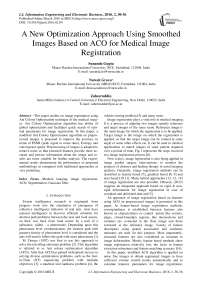A New Optimization Approach Using Smoothed Images Based on ACO for Medical Image Registration
Автор: Sunanda Gupta, Naresh Grover, Zaheeruddin
Журнал: International Journal of Information Engineering and Electronic Business(IJIEEB) @ijieeb
Статья в выпуске: 2 vol.8, 2016 года.
Бесплатный доступ
This paper studies on image registration using Ant Colony Optimization technique of the medical imag-es. Ant Colony Optimization algorithm has ability of global optimization and facilitates quick search of opti-mal parameters for image registration. In this paper, a modified Ant Colony Optimization algorithm on prepro-cessed images is proposed to improve the accuracy in terms of PSNR (peak signal to noise ratio), Entropy and convergence speed. Preprocessing of images is adopted to remove noise so that extracted features provide more accurate and precise information about the image and results are more suitable for further analysis. The experi-mental results demonstrate the performance of proposed methodology as compared with traditional approaches as very promising.
Medical imaging, image registration, ACO, Segmentation, Gaussian filter
Короткий адрес: https://sciup.org/15013405
IDR: 15013405
Текст научной статьи A New Optimization Approach Using Smoothed Images Based on ACO for Medical Image Registration
Published Online March 2016 in MECS
Swarm intelligence research is originated from progress work into the simulation of emergence of collective intelligence behavior of real ants. Ants have unusual intelligence to discover efficient solutions for shortest path problems between the nest and food source, on their way back from food source by a trail of a substance, called - a pheromone. Depending upon this pheromone level communication, the shortest path with greatest density of pheromone level is considered and the ants will tend to follow the path with more pheromone [1].
M. Dorigo (1992) was first to use this approach to solve the travelling salesman problem [2]. This algorithm is referred to as Ant colony optimization algorithm (ACO). After that ACO has gained widespread success in solving diverse optimization problems, such as the Justin-Time (JIT) sequencing problem with multiple objectives [3], a machine tool tardiness problem [4], the vehicle routing problem [5] and many more.
Image registration plays a vital role in medical imaging. It is a process of aligning two images namely reference and target images of the same scene. Reference image is the main image for which the registration is to be applied. Target image is the image on which the registration is applied, so that the target image can be rotated at some angle or some other effects etc. It can be used in medical applications to match images of same patient acquired over a period of time. Fig.1 represents the steps involved in a image registration process [6].
An approach of image registration based on features using ACO on preprocessed images is presented in this paper. In feature-based image registration methods, correspondence is established between features also known as characteristics or control points like corners, edges, closed-boundary regions, line intersections and contours etc. extracted in the float image and those extracted in the reference image. Variety of feature descriptors using spatial association and similarity measures are used for this purpose. Most importantly, extracted features are also considered as invariant to image deformation. Mostly feature based methods show image registration relatively fast, but lacks in feature extraction robustness and feature matching accuracy [16].
In this paper, modified ACO algorithm is applied on noise free images to obtain segmented images to have sufficient volume control points automatically and to calculate features' parameters for image registration.
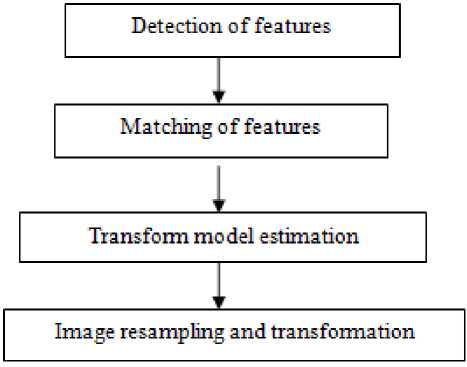
Fig.1. Steps Involved in Image Registration
The rest of the paper is organized as follows: Section II deals with related works done in this field. Section III contains the smoothing process for the images used in image registration. Section IV describes ACO (Ant Colony Optimization) approach to extract the features' parameters; Results for performance measures for proposed methodology are discussed in Section V. Conclusion and Future Scope are presented in Section VI.
-
II. Related Work
Image registration is usually used to extract complementary information of images acquired from different modalities [17] and to examine images of same modality accurately [18, 19]. In medical imaging, image registration enables to locate and estimate subtle changes that appear during acquisition of consecutive images. Many papers based on different image registration techniques like mutual information and genetic algorithm etc. have been studied while completing this work. Maes F. (2003) and Kishankumar M. (2014) proposed mutual information method to measure the information redundancy [20, 21]. Kostelec P.J. (2003) proposed an introduction to image registration applied in medical imaging which is able to spot difference between two images and can be used for medical application later [22]. Andrea (2012), Pandey et.al. (2012) gave new intensity-based image registration (IR) approaches based on a modern, real-coded genetic optimization algorithm [23, 24]. A novel continuous medical image registration (CMIR), fuzzy logic based approach was proposed by Moulick (2013) [25].
-
III. Smoothing
Feature appearance is enhanced using some preprocessing steps like gamma correction and gradient methods due to the noise involved in medical images. Particularly, the accuracy of registration algorithm rely on the quality of procedure opted to obtain segmented images (later used to extract features) in previous step for features matching [12].
Smoothing is done in order to make the image noise free so that maximum amount of information is extracted from the image that results in better feature extraction process. Many filters are used for smoothing. In this proposed approach Gaussian filter is used and the image is first converted into frequency domain by applying FFT and then Gaussian filter is applied on this converted image, for smoothing process. A threshold is set and the components that are out of the frequency threshold are rescaled, with the help of which the noise is removed. The output image is smoothed image with less noise and is used for the registration purpose further. Main reason to prefer Gaussian filter is that mostly the noise that affects the data is Gaussian noise, so this is better for such type of noise
-
IV. ACO (Ant Colony Optimization)
ACO was first introduced by M. Dorigo in 1992. One basic idea of the ACO approach is to use the counterpart of the pheromone trail used by real ants as a medium for communication and as an indirect form of memory of previously found solutions.
Ant colony optimization is a nature-inspired optimization algorithm inspired by food foraging behavior exhibited by ant societies [26, 27]. Through some biologist’s point of view, the visual sensory organs of the real world ants are rudimentary by nature. The ants communicate using a chemical substance called pheromone. In journey of an ant, it accumulates a constant amount of pheromone that other ants can follow and if it came after the trail, the ant’s own pheromone reinforces the current trail, the growth in pheromone increases the probability of the next ant selecting the path. Therefore, the more the ants travel on a path, the more attractive the path becomes for consecutive ants. Over time, as more ants are capable to complete the shorter route. Therefore on shorter paths pheromone densities stay high because pheromone is laid down faster and the longer paths are less reinforced and finally abandoned [28]. This method of positive feedback eventually leads the ants to follow the smaller paths. It is this usual experience that encouraged the development of the ACO meta-heuristic.
Using this kind of method, the main advantage is that, it extracts remarkable features of the image, greatly compresses the image information, and has good robustness, small amount of calculation, fast speed. It only needs four processes including initialization process, construction process, update process and decision process. Fig. 2 represents the steps involved for ACO optimization.
Hill in 1993 proposed a feature space that deployed the combination of corresponding pixels intensities in a set of two images. This feature space alters with the variations in the alignment of the images. If the images are accurately registered, then specific groups for corresponding anatomical structures in feature space could be recognized. In case of non-registration, the structures of reference image do not match to the corresponding pixels in the target image and effects dispersion. This property of the feature space permits the use of dispersion as a image registration measure [29].
Mutual information can be represented in many ways. Mutual information (MI) in terms of Entropy is given as:
MI = H a + H b - H ab (1)
where
H a is Shanon's entropy of reference image
H b is Shanon's entropy of target image
Hab shows joint entropy of reference and target image
Amount of pheromone updated is given as:-
T = ( 1 - P К +^ Т ч (2)
τ i j is the amount of pheromone on edge (i, j) ρ rate of pheromone evaporation
∆τ ij is the amount of pheromone deposited
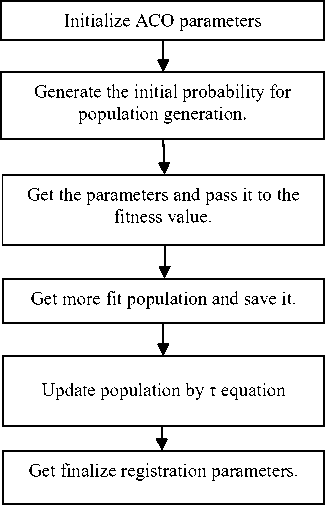
Fig.2. Steps for ACO Optimization
-
A. Proposed Methodology
In an ACO based optimization method, the design of the pheromone update strategy, and the measurement of the quality of the solutions are critical. This technique comprises of two types of images. one image is called reference image and other is called the target image.
Fig.3 depicts the steps of proposed methodology being followed.
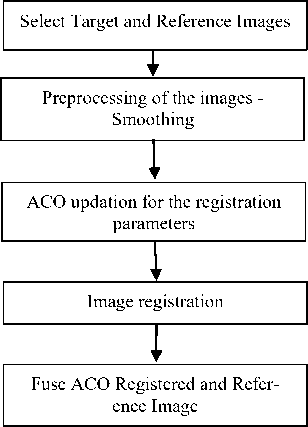
Fig.3. Steps for Proposed Methodology
The steps listed below are being followed while implementing this algorithm in MATLAB for medical image registration using ACO.
Step 1. Choose the reference image and Target image.
-
Tij ^(1 — P)Ти +^k=l ^TU
Step 4. For the population generation generate the initial probablity equation given below:- p . (та )П)
Pj IT )П)
α is a parameter to control the influence of τ ij .
n ij is the desirability of edge (i, j).
β is a parameter to control the influence of n ij .
Step 5. After getting the parameters, pass them to the fitness value.
Using the entropy MI (Mutual information ) equation given below
MI = H a + H b - H ab , .(5)
Step 6. Get the best population out of the population generated by the following equation
т ^(1-pУту + р-^тТ (6)
And finally saves the results.
Step 7. Now, update the population that is saved by the equation (7) given below.
Tij =(1 - p )Tij +ATj (7)
-
V. Results and Discussion
In this paper, image registration based on this algorithm on two types of images (MRI, MRI_1) using Matlab R2013b is performed. The performance, efficiency and robustness of presented algorithm is demonstrated by extensive image registration experiments. Experiments are performed for different angle of rotation. Figs.4-7 show results of medical image registration for different angle of rotations.
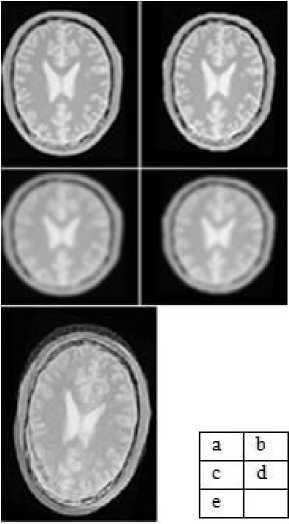
Fig.4. Image MRI_1 with angle of rotation -3 degree (a) Reference image, (b) Target image (c) Preprocessed Reference image (d) Preprocessed target image (e) ACO Registered image
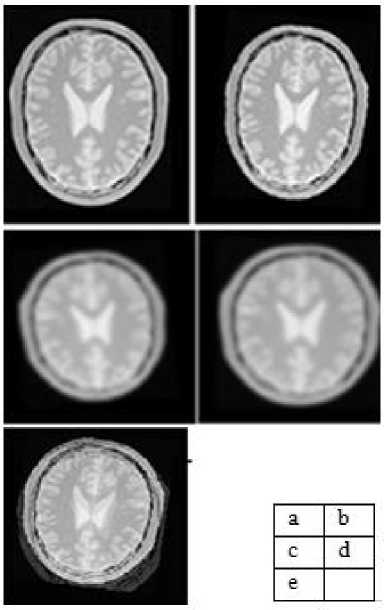
Fig.5. Image MRI_1 with angle of rotation -5 degree (a) Reference image, (b) Target image (c) Preprocessed Reference image (d) Preprocessed target image (e) ACO Registered image
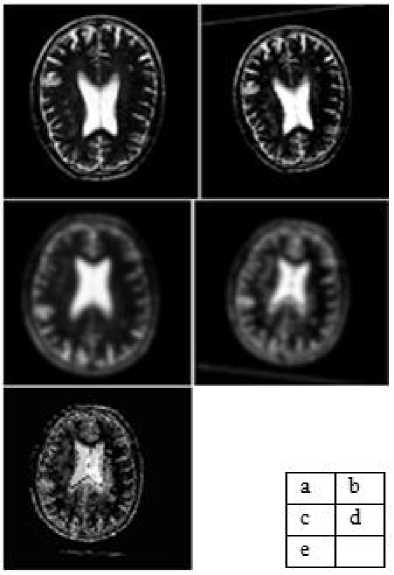
Fig.6. Image MRI with angle of rotation -7 degree (a) Reference image, (b) Target image (c) Preprocessed Reference image (d) Preprocessed target image (e) ACO Registered image
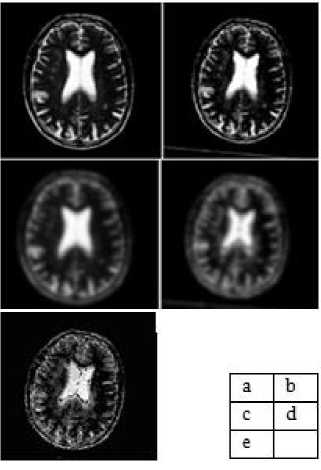
Fig.7. Image MRI with angle of rotation -5 degree (a) Reference image, (b) Target image (c) Preprocessed Reference image (d) Preprocessed target image (e) ACO Registered image
Table 1. Medical Image Registration of Image MRI_1 for Different Rotation Angles
|
Image MRI_1 |
||||||
|
Rotation angle |
θ |
Correlation |
Time (sec) |
Mutual information |
S/N ratio |
MSE |
|
-3 |
-2.9 |
0.66 |
491.7 |
1.25 |
28.71 |
37.34 |
|
-5 |
-5.13 |
0.84 |
523.0 |
1.41 |
32.14 |
39.72 |
|
-7 |
-6.7 |
0.85 |
517.4 |
1.73 |
32.45 |
36.93 |
Table 2. Medical Image Registration of Image MRI for Different Rotation Angles
|
Image MRI |
||||||
|
Rotation angle |
θ |
Correlation |
Time (sec) |
Mutual information |
S/N ratio |
MSE |
|
-3 |
-3.1 |
0.69 |
496.4 |
0.96 |
31.5 |
45.88 |
|
-5 |
-4.9 |
0.69 |
503.1 |
1.15 |
31.73 |
43.61 |
|
-7 |
-7.4 |
0.54 |
502.2 |
0.86 |
31.77 |
43.20 |
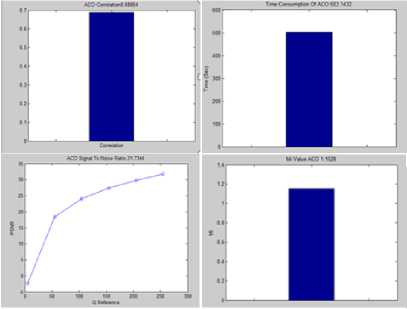
a
c
b d
Fig.8. Image MRI with angle of rotation -5 degree (a) Correlation (b) Time Consumption (c) Signal to Noise ratio (d) Mutual Information
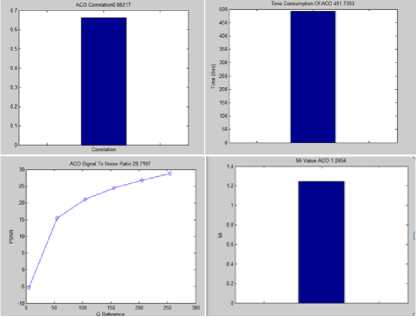
a
c
b d
Fig.9. Image MRI_1 with angle of rotation -3 degree (a) Correlation (b) Time Consumption (c) Signal to Noise ratio (d) Mutual Information
-
VI. Conclusion and Future Scope
In this work, a new approach of medical image registration based on ACO on smoothed images for image segmentation and for extracting points' features is proposed. Results are obtained for different rotation angles. It is inferred that proposed algorithm shows good registration when float image is rotated at an angle. Also, the proposed registration algorithm is robust against different image transformations like standard SIFT, other recent fuzzy and neural based methods quantitatively.
Here registration is implemented for single modality image registration and needs to be extended and tested for multimodality image registration. The proposed registration algorithm also needs to be tested for image registration in case of scaled float image.
Список литературы A New Optimization Approach Using Smoothed Images Based on ACO for Medical Image Registration
- Wen Peng, Ruofeng Tong, Guiping Qian, Jinxiang Dong, "A Constrained Ant Colony Algorithm for Image Regis-tration " Computational Intelligence and Bioinformatics Volume 4115 of the series Lecture Notes in Computer Science pp 1-11.
- Dorigo, M. (1992), "Optimization, Learning and Natural Algorithms". Ph.D. Thesis, Italy.
- McMullen, P.R., 'An Ant Colony Optimization Approach to Addressing a JIT Sequencing Problem with Multiple Objectives'. Artificial Intelligence, 309–317 (2001).
- Bauer, A., Bullnheimer, B., Hartl, R.F., 'An Ant Colony Optimization Approach for the Single Machine Tool Tar-diness Problem'. In: Proceeding of the Congress on Evolu-tionary Computation, pp. 1445–1450 (1999).
- Bullnheimer, B., Hartl, R.F., Strauss, C., (1997)," Apply-ing the Ant System to the Vehicle Routing Problem". In: The Second Metaheuristics International Conference, France.
- Gupta,S., chakarvarti,S.K. & Zaheeridin (2013), "Image Registration Methods: A Short Review ", Columbia Inter-national Publishing American Journal of Algorithms and Computing (2013) Vol. 1 No. 1 pp. 39-49.
- Sharma, N., Ray, A.K., Sharma, S., Shukla, K.K., Pradhan, S. and Aggarwal, L.M. (2008), "Segmentation and classi-fication of medical images using texture-primitive features: Application of BAM-type artificial neural network", J. Med. Phys. 33, pp. 119–126.
- De-Nigris, D., Collins, DL. and Arbel, T.( 2012 ),'Multi-modal image registration based on gradient orientations of minimal uncertainty', IEEE Transactions on Medical Im-aging, Vol. 31, pp. 2343 - 2354
- De-Nigris, D., Collins, DL. and Arbel, T. (2013),"Fast rigid registration of pre-operative magnetic resonance im-ages to intra-operative ultrasound for neurosurgery based on high confidence gradient orientations", International Journal of Computer Assisted Radiology and Surgery, pp.649-61.
- Joglekar, Jyoti and Shirish, S. (2012) 'Area Based Image Matching Methods: A Survey', International Journal of Emerging Technology and Advanced Engineering ISSN 2250-2459, Vol. 2, issue1.
- Roy, Sujoy (2010) ' Region- based image registration for mosaicking ', International Journal of Computer Applica-tions in Technology, Vol. 37, No.1 pp. 59 - 73.
- Gupta,S., Chakarvarti, S.K. & Zaheeridin (2016), "Medical image registration based on Fuzzy c-means clustering segmentation approach using SURF", Int. J. Biomedical Engineering and Technology, Vol. 20, No. 1, pp.33–50.
- Cifor, A., Risser, L., Chung, D., Anderson, EM. and Schnabel, JA. (2013) 'Hybrid feature-based diffeomorphic registration for tumor tracking in 2-D liver ultrasound images' IEEE Transactions on Medical Imaging, pp.1647-56.
- Farnia, P., Ahmadian, A., Shabanian, T., Serej, ND and Alirezaie, J. (2014) 'A hybrid method for non-rigid regis-tration of intra-operative ultrasound images with pre-operative MR images', international conference Proceedings IEEE in Engineering in Medicine and Biology Society (EMBC), pp.5562-65.
- Dhawan, Atam P. (2012) 'Rigid and non- rigid medical image registration methods', International Journal of Bio-medical Engineering and Technology Vol. 8, No.2/3 pp. 200 - 219.
- Mahmoud, Hassan, Masulli, Francesco and Rovetta, Stefano (2013) 'Feature-Based Medical Image Registration Using a Fuzzy Clustering Segmentation Approach', CIBB LNBI 7845, pp. 37–47, Springer-Verlag Berlin Heidelberg.
- Peter, Dinesh J., Govindan ,V.K. and Mathew, Abraham T. (2009) 'A robust affine parameter estimation using ac-quainted non- convexity multiresolution based registration', International Journal of Computer Aided Engineering and Technology , Vol. 1, No.4 pp. 455 - 479.
- Maintz, J.B.A. and Viergever, M.A. (1998) 'A survey of Medical Image Registration', Medical Image Analysis, Vol. 2, pp.1–36.
- Hallpike, L. and Hawkes, D.J. (2002) 'Medical image registration: an overview', Imaging, Vol. 14, 455–463.
- Maes, F., Vandermeulen, D. & Suetens, P. (2003), "Medi-cal imaging registration using mutual information" pro-ceedings of the IEEE, vol. 91, issue. 10, 1699-1722.
- Kishan kumar, M. & Patel, M., (2014), "Medial Image Registration Based on Information Theoretic Approach". International Journal of Advanced Engineering and Nano Technology (IJAENT), Volume-1, Issue-6, pp 24-26.
- Kostelec P. j. & Periaswamy, S., (2003) "Image Registra-tion for MRI". Modern Signal Processing Publications (MSRI), Volume 46, pp161-184.
- Andrea Valsecchi, Damas, S. & Santamarıa, J., (2012) "An Image Registration Approach using Genetic Algorithms" WCCI IEEE World Congress on Computational Intelligence June, 10-15, pp. 416-423.
- Pandey, N. K., Gupta, A., & Mishra, A. K., Sharma, S. (2012), "Image registration: An application of image pro-cessing", International Journal of Modern Engineering Research (IJMER) Vol. 2, Issue. 5, pp-3271-3274.
- Moulick, H.N. & Chatterjee, A., (2013) "Biomedical Image Registration Using Fuzzy Logic" International Journal of Computer Trends and Technology (IJCTT) – volume 4 Issue 5, pp 1394-1406.
- M. Dorigo and S. Thomas, "Ant Colony Optimization". Cambridge: MIT Press, 2004.
- H.B. Duan, (2005) "Ant Colony Algorithms: Theory and Applications". Beijing: Science Press.
- M. Dorigo, M. Birattari and T. Stutzle, (2006) "Ant colony optimization", in proc. of the IEEE Computational In-telligence Magazine, pp.28.39.
- Kosiński, W., Michalak, P., Gut, P., (2012) "Robust Image Registration Based on Mutual Information measure", Journal of Signal and Information Processing, 3, 175-178.
- P. Viola and W. M. Wells III, (1997) "Alignment by Max-imiza- tion of Mutual Information," International Journal of Com- puter Vision, Vol. 24, No. 2, pp. 137-154.

